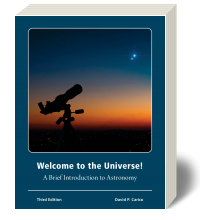Welcome to the Universe! A Brief Introduction to Astronomy
Third Edition Carico, © 2022, 385 pages
This textbook is suitable for an introductory astronomy course.
Request Examination Copy Test Drive LAB BookPrices and ISBNs
This title is available in the following formats.
|
Product
Description ISBN |
Description | ISBN | Bookstore (Net Price) |
Student (Retail Price) |
|
LAB BOOKPlus
Online eBook + Lab978-1-5178-1211-9 |
Online eBook + Lab | 978-1-5178-1211-9 (9781517812119) | $50 | $73 |
|
TEXTBOOKPlus
Loose Leaf + eBook + Lab 978-1-5178-1212-6 |
Loose Leaf + eBook + Lab | 978-1-5178-1212-6 (9781517812126) | $65 | $95 |
Excerpts
Description
With these opening words, Dr. David Carico invites readers to join him on a journey of discovery--a journey that is not only educational, but engaging and awe inspiring like the Universe itself. Welcome to the Universe! A brief introduction to astronomy fulfills the need for a short, lively, non-mathematical textbook covering the vast and fascinating field of astronomy. Dr. Carico has taught college level astronomy for more than 20 years, at institutions ranging from small private colleges to large state universities. This book emerged as the direct result of his own inability to find a textbook that was ideally suited to the courses he was teaching, or to the students who were taking those courses. Welcome to the Universe! differs from most astronomy textbooks in three principal ways:
- Ideas, not facts:The field of astronomy covers so much material that textbooks often provide "information overload," forcing students into a cram-the-facts mode which might get them through the exams, but will leave very little lasting appreciation of the wonders of the Universe. Welcome to the Universe! takes a simpler, more streamlined approach, focusing primarily on concepts and ideas, leaving it to the instructor's discretion to introduce supplemental facts and data.
- A journey through time, rather than space: The usual approach to astronomy is to begin with the solar system and work outward through ever greater expanses of space. Welcome to the Universe! takes a very different approach, beginning with the Big Bang and following the evolution of the Universe through time. Not only does this give a wonderful starting place for the course "the idea of space, time, and energy being created from a single point of nothingness is a great way to catch attention!" but also, key topics emerge more naturally. A brief introduction to galaxies leads to the study of stars; which in turn enables students to appreciate the Sun and the solar system in a larger context. Then, rather than simply being told that the Sun is mostly hydrogen, they know that it must be mostly hydrogen, and they know why it must be, because they have already learned about the initial creation of elementary particles and primordial nucleosynthesis.
- Writing that is worth reading: Most of your students are not going to be astronomers, or even scientists. So why should their astronomy book be written like a technical journal? Welcome to the Universe! is written in a lively, conversational style. Your students will actually want to read it!
Welcome to the Universe! is a highly readable, simple, yet thorough textbook, that provides every interested reader with a memorable introduction to this amazing Universe of ours.

